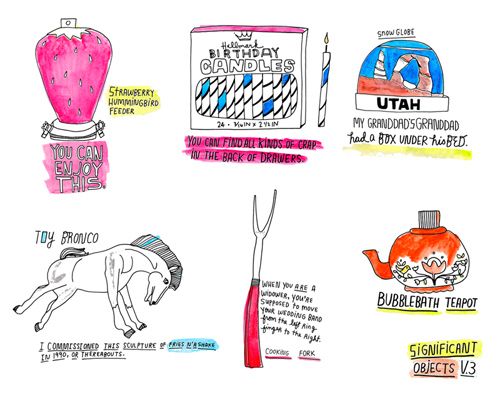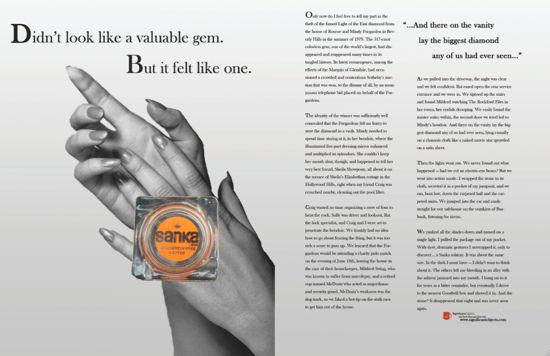Significant Objects: The book
Finally announced, here.
Finally announced, here.
This morning, Significant Objects (the side project I work on with co-founder Joshua Glenn), wrapped up its third volume. With our final v3 auction concluded, we converted $58.28 worth of thrift-shop bric-a-brac, paired with 50 stories by our amazing contributing writers, into a whopping $1,748.82 — which will now be donated to Girls Write Now.
GWN is a nonprofit that “provides guidance, support, and opportunities for New York City’s underserved or at-risk high school girls, enabling them to develop their creative, independent voices, explore careers in professional writing, and learn how to make healthy choices in school, career, and life.” While it’ s obviously too late to help GWN by buying a Significant Object, you can still support this fine organization by purchasing one of the limited-edition yet highly affordable Significant Objects v3 prints by Kate Bingaman-Burt, from 20X200.
Stay tuned to Significant Objects for news of that project’s future.
I teased this last week — and now it’s here! We’re really excited to announce the latest Significant Objects team-up, resulting in thoroughly affordable art, and another way to support v3 beneficiary Girls Write Now.
The prints you see on this page are available in limited editions from 20×200, Jen Bekman’s online project that sells a dazzling array of prints from an impressive roster of artists, all priced to meet a mission of making art available to all.
The artist is Kate Bingaman-Burt, whose delightful book Obsessive Consumption was just published, and whose combination of thoughtfulness about consumer behavior and mad drawing skills make her our perfect match.
All these prints are created using archival pigment inks on 100% cotton rag paper with a matte finish.

8×10; edition of 200: $20!
Proceeds from the sale of these prints will benefit Girls Write Now, contributing to Significant Object’s grand total donation.
Girls Write Now provides guidance, support, and opportunities for New York City’s underserved or at-risk high school girls, enabling them to develop their creative, independent voices, explore careers in professional writing, and learn how to make healthy choices in school, career and life.
I mentioned that I’d have a couple of bits of news from the Significant Objects project that might be of interest to Murketing readers. Here’s one bit.
Today’s story (part of our Paola Antonelli team up, co-published on Core77) is by Matt Brown. I’ve mentioned him a couple of times here in the past; a post on Metafilter described him as a “design fiction enthusiast,” which sounded close enough to my interest in imaginary brands that I was curious. And his work just completely blows me away: He has a peculiar genius for devising alternative histories for random, mass-produced stuff, and expressing this design fiction with both words and, more unusually, completely invented packaging. (In fact he’s now doing a series for Core77, Design Fancy.)
We knew we wanted him involved in Significant Objects. And when Paola Antonelli presented me with her objects, there was one that struck me as being perfect for Brown. This:
What is it? Well, Anotelli wouldn’t tell me. Turns out Brown, as I suspected, had an answer. It’s a “crumpter.”
A crumpter, it turns out, is a sort of analog precedent to autotune. Never heard of that? Oh, well then, please read the story over at S.O.
And yes, all the collateral material Brown created is part of the auction.
We’ve sold a mystery object, we’ve sold a story that was itself an object, and now an object whose story is told in part through its packaging.
 Okay I so I dialed back the constant mentions of Significant Objects on this site, but this might be of interest to some of you: We have a special week-long event underway, a set of objects “curated” for us by an actual curator — Paola Antonelli, of MoMA — with the stories co-published on one of my very favorite sites, Core77. A story a day, all week.
Okay I so I dialed back the constant mentions of Significant Objects on this site, but this might be of interest to some of you: We have a special week-long event underway, a set of objects “curated” for us by an actual curator — Paola Antonelli, of MoMA — with the stories co-published on one of my very favorite sites, Core77. A story a day, all week.
Pretty cool. Proceeds for our current batch of object auctions are all going to Girls Write Now. Your help in spreading the word about this is always appreciated.
One or two more pieces of news about S.O. in the next week or so, but I promise not to get carried away.
As some of you know, we’ve launched Significant Objects — Volume 3. This series of objects/stories/auctions raises money for Girls Write Now, which is a great organization.
This week we’ve published stories by Jennifer Weiner, Padgett Powell, David Levine, and Charles Baxter (and tomorrow Jim Hanas). Much, much more to come, including many team-ups and special events.
Please check it out and help us spread the word.
Thanks.

Those of you who know about the Significant Objects project but who haven’t checked it out lately may be interested in a batch of recent posts over there, in which I show off the creations of a SCAD advertising class that made ads for Significant Objects. I’ve noted before that some observers of the project see parallels between S.O. and advertising, so I thought this would be a pretty cool exercise, and I’m really pleased with the results. Fun.
The Significant Objects project has conclusively demonstrated that narrative adds measurable value to objects.
What does this imply about the objects themselves, and whoever created and produced them? Something I hear often from assorted gurus on design, marketing, and the like, is that consumers value the story of an object in the sense of knowing how that object was made, or designed. Did a recognized Design Genius dream it up? Is there footage of the whiteboard meetings where the genius insight was arrived at? Or: Was the object crafted by hand? Perhaps knowing more about the crafter’s skill-acquisition history, or personal ideology, adds valuable narrative.
Yet the Significant Objects project added measurable value even while explicitly ignoring such matters. Every Significant Object carries two narratives, but neither has anything to do with the kinds of stories just suggested. Instead there is the narrative invented by the writer who has agreed to create a story about whatever doodad is for sale; and, in addition, there is the story of the project itself. Probably both of these narratives add value to some extent, with specifics varying from buyer to buyer. But while most of the objects sold over the course of the project have been mass-produced, the intent of whoever designed them, whoever marketed them, and why, and how, is flagrantly disregarded, replaced with pure fiction. Arguably, Significant Objects obliterates designer/producer intent.
Still, whatever the fate of that intent, its results remain in the form of thing itself. Clearly some item sold by Significant Objects have been more intrinsically appealing than others, and it must be conceded that however much our writers’ stories increased the value of an object in the open market, the aesthetics of the object must figure in somehow.
Which brings me to a recent Significant Object: the Mystery Object, with story by Ben Greenman. In this instance, not only is the designer’s intent ignored, not only is the material backstory disregarded, the object itself is not present.
What we have is Ben Greenman’s narrative about the object, and perhaps the narrative of Significant Objects as a project — to which the addition of a non-present object of course adds yet another pleasing plot twist. By eliminating the object itself from the equation until after the bidding has concluded, this auction sells invented Significance in its purest, most uncut form yet.
In a sense, this makes the Mystery Object unique even among the project’s already-singular series of offerings; as a result, it may be the most valuable object yet, not despite its absence from the scene until the moment that value is determined, but because of that absence. Who wouldn‘t want to own such a thing — whatever it is?
Bidding stands at $28.50.
UPDATE: It sold for $103.50. That’s pretty Significant, don’t you agree? Details here.
[ NOTE: This is a retroactive cross-post from SignificantObjects.com. That is to say, I wrote it for that site, with a view to making a point about how our project is a form of upcycling — but because it’s done with words, not by physically altering low-value objects, we get no “green” cred from the people who are in charge of doling out said cred. I partly made the point by noting that art that involved destroying (presumably unwanted) books gets props by converting these vessels for words into raw material; meanwhile, actual words don’t get the same respect. That was sort of my point, anyway. Since then, since I’ve been doing the books: the idea series, and this stuff relates to it, I’ve retroactively ported a cross-post over here, giving it the same date that it appeared on S.O. I hope that’s okay! ]
Significant Objects has many obvious virtues — but is it eco-friendly, too?
In the early days of trying to drum up traffic, I brought our project to the attention of several eco-blog types. Why? Because we figured that in converting near-worthless thrift-store junk into valuable and meaningful objects, our project was in effect upcycling with words.
I guess I did a bad job making this case, because none of the eco-bloggers bit, and it beats me why that is. Okay, so we’re not converting metric tons of spent plastic water bottles into hip t-shirts or somesuch. But surely if a sculptor incorporated some of the very same doodads you’re used to seeing on this site into a physical work of art and displayed it in a gallery, anybody would recognize that action as redeeming a bit of borderline junk with no particular use-value. Aren’t our writers doing the same?
Probably as a result of this I’ve been interested lately in examples of upcycled art and design that uses one specific form of object as its base material: the book.
This rather astounding roundup at Dark Roasted Blend (which I used to find the images for this post; click on any picture to go to the artist’s site) will provide you every example you need of books converted into pure objects; whatever words they contain hardly matter.
But I’m not here to rattle on about the special-ness of physical books and whatnot, as there are plenty of people around doing that already. And besides, a lot of these book-repurposings are pretty cool. I respect the artistry and craft involved. Speaking of artistry and craft, what I am here to do is say it loud and proud: The writers who’ve been participating in the Significant Objects project are also deploying their artistry and craft in a way that redeems borderline junk with no particular use-value. Read more